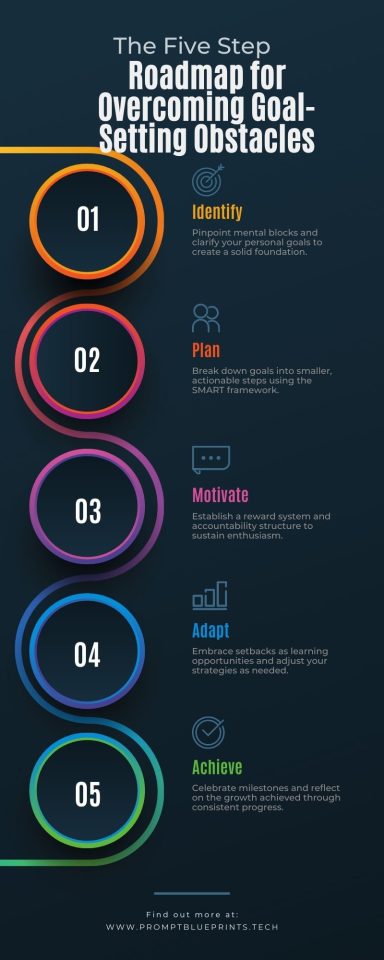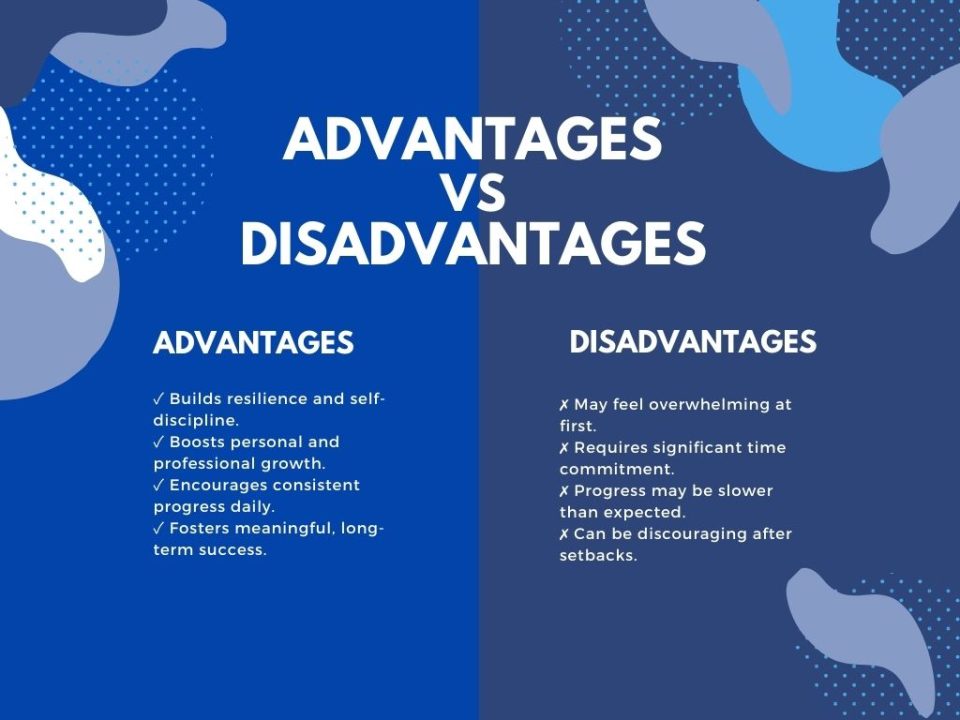Overcoming Goal-Setting Obstacles

Download or listen to our AI Podcast on this Overcoming Goal-Setting Obstacles
Setting goals is an essential part of achieving success in both personal and professional life, but many people encounter obstacles that hinder their progress. Whether it’s a lack of motivation, mental blocks, or difficulties in maintaining consistency, these barriers can make it challenging to achieve goals. In this guide, we’ll explore the psychology behind success and failure, and offer actionable steps to help you overcome common goal-setting obstacles.
Mental Blocks
Mental blocks often prevent us from even starting on our goals. These can stem from fear of failure, self-doubt, or being overwhelmed by the size of a task.
How to Overcome Mental Blocks:
- Break Down the Goal: Divide the goal into smaller, manageable steps. For instance, if your goal is to write a book, focus on completing one chapter at a time.
- Visualize Success: Picture what achieving your goal looks and feels like. Visualization has been shown to boost confidence and focus.
- Challenge Negative Beliefs: Identify self-defeating thoughts and reframe them. Replace “I can’t do this” with “I’ll try my best, one step at a time.”
Common Mistakes:
- Setting vague or undefined goals.
- Procrastinating due to fear of imperfection.
- Overthinking the process instead of starting.
Expert Tip: Use journaling to identify mental blocks and track progress in overcoming them.
Motivation Maintenance
Sustaining motivation is one of the toughest challenges in the goal-setting process. Enthusiasm often wanes after the initial excitement fades.
Strategies to Maintain Motivation:
- Set SMART Goals: Specific, Measurable, Achievable, Relevant, and Time-bound goals keep you focused.
- Celebrate Small Wins: Acknowledge and reward progress, no matter how small.
- Find Accountability: Share your goal with a friend or join a group with similar objectives.
Common Mistakes:
- Overloading yourself with too many goals at once.
- Ignoring the importance of rest and self-care.
- Comparing your progress to others’.
Expert Tip: Create a vision board to serve as a daily reminder of why the goal matters.

Resilience Building
Resilience is the ability to bounce back from setbacks, which is crucial when pursuing challenging goals.
How to Build Resilience:
- Embrace Failure: View setbacks as learning opportunities rather than dead ends.
- Cultivate a Growth Mindset: Believe that your abilities can improve with effort and perseverance.
- Practice Mindfulness: Stay present and manage stress through meditation or deep-breathing exercises.
Common Mistakes:
- Dwelling on past failures instead of learning from them.
- Giving up too soon after encountering obstacles.
- Ignoring feedback from others.
Expert Tip: Keep a resilience journal to document challenges you’ve overcome and the lessons you’ve learned.
Learn About Prompting
Here are some prompts to help you reflect on your goals and strategies to improve:
Actionable Prompts:
- What mental blocks are holding me back from achieving my goals?
- How can I break my goal into smaller, actionable steps?
- What is my “why” for pursuing this goal?
- Who can help hold me accountable?
- What strategies will keep me motivated in the long term?
- How do I currently respond to setbacks?
- What small changes can I make today to get closer to my goal?
- How can I align my goals with my core values?
- What does success look like for me?
- What rewards can I use to celebrate progress?
Understanding Good vs. Bad Prompts:
Good Prompts:
- Are clear and focused (e.g., “What specific action will I take today?”).
- Encourage self-reflection (e.g., “What habits can I improve to support my goal?”).
- Inspire action (e.g., “What one thing can I do right now to make progress?”).
Bad Prompts:
- Are vague or generic (e.g., “How do I achieve my goals?”).
- Focus on negatives (e.g., “Why am I failing at this?”).
- Lack actionable elements (e.g., “What should I do?”).
Common Mistakes with Prompting:
- Overloading yourself with too many questions at once.
- Ignoring prompts that require deep introspection.
- Using prompts as a replacement for action instead of a guide.
Roadmap for Overcoming Goal-Setting Obstacles

Case Studies and Results
Example: Lisa’s Goal to Improve Fitness
Lisa struggled with staying consistent in her fitness routine. By setting a SMART goal to work out for 30 minutes, 3 times a week, and tracking her progress in a journal, she achieved her target within two months. Lisa also relied on an accountability partner, which kept her motivated during tough weeks.
Metrics and Results:
- 90% adherence to her fitness routine.
- Reduced stress levels and improved physical health.
- Boosted confidence and developed a habit of consistency.
Checklist for Success:
- Define clear, meaningful goals.
- Break them into smaller steps.
- Build resilience through setbacks.
- Celebrate progress regularly.
Advantages & Disadvantages of Overcoming Goal-Setting Obstacles
Overcoming goal-setting obstacles requires self-awareness, motivation, and resilience. By breaking down mental blocks, maintaining focus, and cultivating a growth mindset, you can achieve even the most challenging goals. Start small, stay consistent, and remember: progress is more important than perfection.

Take the first step toward achieving your meaningful goals today by reflecting on your “why” and creating a plan. Success is within reach!



